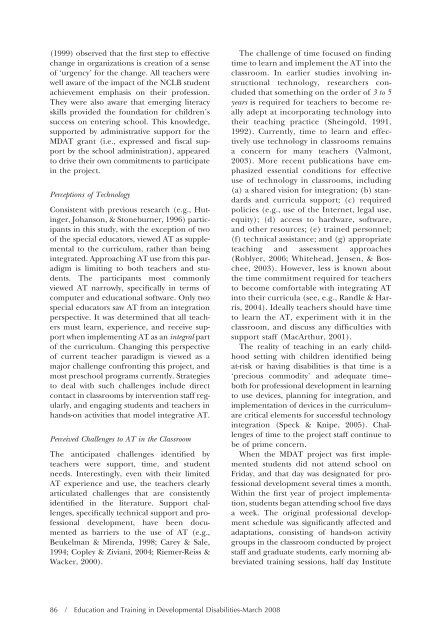Download the Journal (PDF) - Division on Autism and ...
Download the Journal (PDF) - Division on Autism and ...
Download the Journal (PDF) - Division on Autism and ...
Create successful ePaper yourself
Turn your PDF publications into a flip-book with our unique Google optimized e-Paper software.
(1999) observed that <str<strong>on</strong>g>the</str<strong>on</strong>g> first step to effective<br />
change in organizati<strong>on</strong>s is creati<strong>on</strong> of a sense<br />
of ‘urgency’ for <str<strong>on</strong>g>the</str<strong>on</strong>g> change. All teachers were<br />
well aware of <str<strong>on</strong>g>the</str<strong>on</strong>g> impact of <str<strong>on</strong>g>the</str<strong>on</strong>g> NCLB student<br />
achievement emphasis <strong>on</strong> <str<strong>on</strong>g>the</str<strong>on</strong>g>ir professi<strong>on</strong>.<br />
They were also aware that emerging literacy<br />
skills provided <str<strong>on</strong>g>the</str<strong>on</strong>g> foundati<strong>on</strong> for children’s<br />
success <strong>on</strong> entering school. This knowledge,<br />
supported by administrative support for <str<strong>on</strong>g>the</str<strong>on</strong>g><br />
MDAT grant (i.e., expressed <strong>and</strong> fiscal support<br />
by <str<strong>on</strong>g>the</str<strong>on</strong>g> school administrati<strong>on</strong>), appeared<br />
to drive <str<strong>on</strong>g>the</str<strong>on</strong>g>ir own commitments to participate<br />
in <str<strong>on</strong>g>the</str<strong>on</strong>g> project.<br />
Percepti<strong>on</strong>s of Technology<br />
C<strong>on</strong>sistent with previous research (e.g., Hutinger,<br />
Johans<strong>on</strong>, & St<strong>on</strong>eburner, 1996) participants<br />
in this study, with <str<strong>on</strong>g>the</str<strong>on</strong>g> excepti<strong>on</strong> of two<br />
of <str<strong>on</strong>g>the</str<strong>on</strong>g> special educators, viewed AT as supplemental<br />
to <str<strong>on</strong>g>the</str<strong>on</strong>g> curriculum, ra<str<strong>on</strong>g>the</str<strong>on</strong>g>r than being<br />
integrated. Approaching AT use from this paradigm<br />
is limiting to both teachers <strong>and</strong> students.<br />
The participants most comm<strong>on</strong>ly<br />
viewed AT narrowly, specifically in terms of<br />
computer <strong>and</strong> educati<strong>on</strong>al software. Only two<br />
special educators saw AT from an integrati<strong>on</strong><br />
perspective. It was determined that all teachers<br />
must learn, experience, <strong>and</strong> receive support<br />
when implementing AT as an integral part<br />
of <str<strong>on</strong>g>the</str<strong>on</strong>g> curriculum. Changing this perspective<br />
of current teacher paradigm is viewed as a<br />
major challenge c<strong>on</strong>fr<strong>on</strong>ting this project, <strong>and</strong><br />
most preschool programs currently. Strategies<br />
to deal with such challenges include direct<br />
c<strong>on</strong>tact in classrooms by interventi<strong>on</strong> staff regularly,<br />
<strong>and</strong> engaging students <strong>and</strong> teachers in<br />
h<strong>and</strong>s-<strong>on</strong> activities that model integrative AT.<br />
Perceived Challenges to AT in <str<strong>on</strong>g>the</str<strong>on</strong>g> Classroom<br />
The anticipated challenges identified by<br />
teachers were support, time, <strong>and</strong> student<br />
needs. Interestingly, even with <str<strong>on</strong>g>the</str<strong>on</strong>g>ir limited<br />
AT experience <strong>and</strong> use, <str<strong>on</strong>g>the</str<strong>on</strong>g> teachers clearly<br />
articulated challenges that are c<strong>on</strong>sistently<br />
identified in <str<strong>on</strong>g>the</str<strong>on</strong>g> literature. Support challenges,<br />
specifically technical support <strong>and</strong> professi<strong>on</strong>al<br />
development, have been documented<br />
as barriers to <str<strong>on</strong>g>the</str<strong>on</strong>g> use of AT (e.g.,<br />
Beukelman & Mirenda, 1998; Carey & Sale,<br />
1994; Copley & Ziviani, 2004; Riemer-Reiss &<br />
Wacker, 2000).<br />
86 / Educati<strong>on</strong> <strong>and</strong> Training in Developmental Disabilities-March 2008<br />
The challenge of time focused <strong>on</strong> finding<br />
time to learn <strong>and</strong> implement <str<strong>on</strong>g>the</str<strong>on</strong>g> AT into <str<strong>on</strong>g>the</str<strong>on</strong>g><br />
classroom. In earlier studies involving instructi<strong>on</strong>al<br />
technology, researchers c<strong>on</strong>cluded<br />
that something <strong>on</strong> <str<strong>on</strong>g>the</str<strong>on</strong>g> order of 3to5<br />
years is required for teachers to become really<br />
adept at incorporating technology into<br />
<str<strong>on</strong>g>the</str<strong>on</strong>g>ir teaching practice (Sheingold, 1991,<br />
1992). Currently, time to learn <strong>and</strong> effectively<br />
use technology in classrooms remains<br />
a c<strong>on</strong>cern for many teachers (Valm<strong>on</strong>t,<br />
2003). More recent publicati<strong>on</strong>s have emphasized<br />
essential c<strong>on</strong>diti<strong>on</strong>s for effective<br />
use of technology in classrooms, including<br />
(a) a shared visi<strong>on</strong> for integrati<strong>on</strong>; (b) st<strong>and</strong>ards<br />
<strong>and</strong> curricula support; (c) required<br />
policies (e.g., use of <str<strong>on</strong>g>the</str<strong>on</strong>g> Internet, legal use,<br />
equity); (d) access to hardware, software,<br />
<strong>and</strong> o<str<strong>on</strong>g>the</str<strong>on</strong>g>r resources; (e) trained pers<strong>on</strong>nel;<br />
(f) technical assistance; <strong>and</strong> (g) appropriate<br />
teaching <strong>and</strong> assessment approaches<br />
(Roblyer, 2006; Whitehead, Jensen, & Boschee,<br />
2003). However, less is known about<br />
<str<strong>on</strong>g>the</str<strong>on</strong>g> time commitment required for teachers<br />
to become comfortable with integrating AT<br />
into <str<strong>on</strong>g>the</str<strong>on</strong>g>ir curricula (see, e.g., R<strong>and</strong>le & Harris,<br />
2004). Ideally teachers should have time<br />
to learn <str<strong>on</strong>g>the</str<strong>on</strong>g> AT, experiment with it in <str<strong>on</strong>g>the</str<strong>on</strong>g><br />
classroom, <strong>and</strong> discuss any difficulties with<br />
support staff (MacArthur, 2001).<br />
The reality of teaching in an early childhood<br />
setting with children identified being<br />
at-risk or having disabilities is that time is a<br />
‘precious commodity’ <strong>and</strong> adequate time-both<br />
for professi<strong>on</strong>al development in learning<br />
to use devices, planning for integrati<strong>on</strong>, <strong>and</strong><br />
implementati<strong>on</strong> of devices in <str<strong>on</strong>g>the</str<strong>on</strong>g> curriculum-are<br />
critical elements for successful technology<br />
integrati<strong>on</strong> (Speck & Knipe, 2005). Challenges<br />
of time to <str<strong>on</strong>g>the</str<strong>on</strong>g> project staff c<strong>on</strong>tinue to<br />
be of prime c<strong>on</strong>cern.<br />
When <str<strong>on</strong>g>the</str<strong>on</strong>g> MDAT project was first implemented<br />
students did not attend school <strong>on</strong><br />
Friday, <strong>and</strong> that day was designated for professi<strong>on</strong>al<br />
development several times a m<strong>on</strong>th.<br />
Within <str<strong>on</strong>g>the</str<strong>on</strong>g> first year of project implementati<strong>on</strong>,<br />
students began attending school five days<br />
a week. The original professi<strong>on</strong>al development<br />
schedule was significantly affected <strong>and</strong><br />
adaptati<strong>on</strong>s, c<strong>on</strong>sisting of h<strong>and</strong>s-<strong>on</strong> activity<br />
groups in <str<strong>on</strong>g>the</str<strong>on</strong>g> classroom c<strong>on</strong>ducted by project<br />
staff <strong>and</strong> graduate students, early morning abbreviated<br />
training sessi<strong>on</strong>s, half day Institute
















